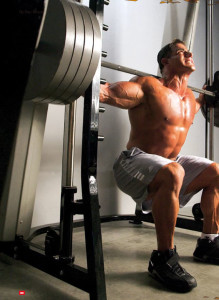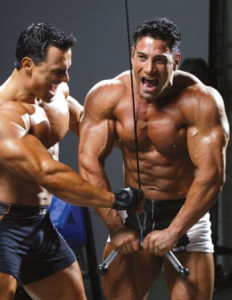Maximal Stimulation For Maximal Growth
(Australian Ironman magazine article by Ben Minos – click here to view PDF of actual article)
How inefficient would your training be if you were only recruiting a fraction of all your available muscle fibres? Well, many of you are.

We all know that a muscle cell can’t grow if it is never properly stimulated. Many of you, unknowingly of course, are probably not even tapping into most of your muscle fibres when you train, meaning that you are only getting partial muscle stimulation, and therefore, only part of your potential growth.
It doesn’t matter how hard you push and how much weight you lift, if you only activate the same muscle fibres every session, you aren’t going to get near as much growth as if you tapped in to all of the available fibres.
Bodybuilding great Milos Sarcev has a popular saying: “Partial range of motion equals partial development; full range of motion equals full development”. I’m going to take it one step further. Partial stimulation of muscle fibres leads to partial growth; maximal stimulation of the muscle fibres equals maximal growth. If you want maximal growth, then you need to find a way to stimulate and activate all possible muscle fibres.
What is a motor unit?
A motor unit is considered the functional unit of a muscle and consists of a nerve and all of the muscle fibres that the nerve innervates. Each muscle fibre, however, is innervated by only one nerve branch. That means that the only way that a muscle fibre can be activated is via the activation of its corresponding nerve branch. A nerve may supply only a small number of muscle fibres, while another nerve may supply thousands of muscle fibres. But, each muscle fibre is only ever innervated by one single nerve branch.
This is an extremely important concept. It’s only when the nerve is stimulated that its corresponding muscle fibres are able to contract. Each motor unit acts on an ‘all or nothing’ principle.
Think of it as a light switch in your house. All the electricity comes from the same source, but a light only switches on when you turn on its activating switch. It doesn’t matter how hard or soft you flick the switch, the light either switches on or off. The most important point concerning the human body is, you can turn on the kitchen and bathroom lights all you want, but that still doesn’t make your bedroom light switch on, and if your bedroom light is never switched on, it will never get bright.
Specificity of motor unit activation
Although we now know that the only way for specific muscle fibres to get activated is to stimulate the specific motor unit that supplies those fibres, there’s still more to this story.
Motor unit activation is very specific to the actual movement that is being performed. Motor units behave in a specific way that is the same for every person. Firstly, they are recruited in order from smallest to biggest. Some motor units may be made up of a few hundred fibres, while others top up into the thousands. And, it’s always the smaller ones that get activated first, and if the demands are great enough, the bigger ones are called into play. Your body wants to be as efficient as possible, so it will only use just as much force as is necessary to carry out an action.
Motor unit activation is also very specific to the type of movement being performed and the manner in which it is carried out. This is referred to as the specificity of motor unit activation, and it is a very important concept when you look at training for various sports.
Different joint angles, different movement patterns etc., all equal different motor unit activation, which in turn means the activation of different muscle fibres. Athletes need to mimic movement patterns in their chosen sport as incorrect training can lead to alterations in neural activation, timing and patterning, and can cause a subsequent decrease in performance.
Athletes need to mimic the same neural pathways, the same metabolic processes, the same movement patterns, and speed of movement that they encounter in their specific sporting situation. That’s why you never try to improve your golf swing by swinging a heavier club; this will actually cause an alteration in the neural pathways activated. The key word I used was mimic. You must imitate the movement patterns, not simulate.
You should always treat strength training as a skill. The more you practice, the better you get. Strength is very specific. The goal of the strength athlete is to repeatedly mimick the movement pattern of their sport so that they become more efficient with that movement. They ‘groove’ the right action by consistently stimulating the exact same motor units in the exact same way, every single time.
If you make minor changes to even your foot position or grip width, or wear different shoes, use lifting straps or a lifting belt, this drastically alters your neural recruitment pattern and can actually lead to a decrease in performance. This is why you don’t see sprinters training on a bike, or Olympic lifters doing a lot of leg presses. They would activate a completely different set of motor units and train a different set of muscle fibres than what they use in their sporting situation. What a waste of time!
Why Bodybuilders need to learn the rules… and do the opposite!

There’s a great difference in training for a neural adaptation (athlete) compared to training for a metabolic or physiological adaptation (bodybuilder). As a bodybuilder, your main goal is for complete and optimal muscular development.
From the above discussion, you can see that if you perform, say, the bench press, the exact same way with the same grip width, always with a barbell, with the same speed, in the same rep range, to the same spot on your chest, with the same groove over and over again, you will only activate a certain neural pathway, and therefore, only a certain number of motor units will ever be activated.
If motor unit activation is so specific, then the muscle fibres that you subsequently activate are very specific also. Therefore there is an incomplete muscle fibre activation. You have all of these other muscle fibres belonging to different motor units that never get properly stimulated at all. You have a goldmine of potential growth just waiting to happen in fibres that you have never even tapped into.
The problem is, a lot of bodybuilders get caught up in the above scenario, usually out of habit, maybe out of laziness, or quite simply, they just don’t know any better. Most are too concerned with ‘how much they bench’ with little concern as to whether or not it is stimulating the most amount of chest fibres to maximise growth.
If you’re like most, you’ll use the same exercises, the same grip, the same weights, the same reps and the same equipment, workout after workout. This leads to the same motor units getting activated, which equals the same muscle fibres getting stimulated in the same way, meaning no new meaningful gains in these activated fibres and absolutely no activation in the other unstimulated fibres. Again, great if you’re a powerlifter looking to specialise in a certain lift, but it may not be the best approach if maximal muscle gain is your goal.
Remember, you need to at least switch the fibres on if you ever want to stimulate them to grow. Don’t fall in to the same trap that everybody else does. Don’t do the same old exercises in the exact same way on the same pieces of equipment every workout. If you do, you’ll have an untapped resource of muscle fibres that will never get stimulated. If these motor units remain untapped, that means that you’ll never stimulate growth in these fibres, which means that you’ll have substandard development and will never gain your maximal potential in size and strength.
What’s the solution?
Well, now that you understand the above principles, you can go ahead and exploit them.
To get maximal stimulation of more motor units, and therefore, more muscle fibres, you can vary bench heights, use different pieces of equipment, change grip positions and widths, use a belt, no belt, straps, no straps, raise the heel in squats, don’t raise the heel, change your foot position, change your shoes, don’t wear shoes… the list is endless. Even just a minor variation of your foot position can drastically alter the neural pathway used to perform a squat.
This would mean different motor unit stimulation, which equals different muscle fibres getting stimulated, which would lead to increased overall development. A whole new bunch of motor units (new muscle fibres) will get activated: ones that you were potentially missing out on before. This is great news, especially for those of you who may have stalled with their gains in either size or strength and are sticking to the same old routine and exercises.
Let’s use the squat again as an example. You could change the bar position, high bar, low bar, back squat, front squat, Zercher squat, hack squat (a true hack squat, not the machine). You can also change your foot position. You can elevate your heels up on to a block, you can point your toes in or out, you can position your feet close together or wider apart. You can even change your foot position with a concurrent change in bar position. All of a sudden a whole new world opens up to you with literally hundreds of combinations and possibilities. And with each new possibility comes a whole new variation in motor unit activation, resulting in different fibres being stimulated.
And you know what? It will provide you with a new mental challenge – a new goal to reach for. Just try and squat with your heels up and the bar slightly higher on your shoulders; immediately you’ll have to drastically decrease the poundage lifted.
You can also use different pieces of equipment such as smith machines, plate loaded, pin loaded, dumbbells, barbells, kettlebells… the possibilities are endless.
So now you’re on your way

There are a few caveats to the above. For example, I don’t just simply use variety for variety’s sake. It still has to be part of a properly planned program and implemented according to your individual goals. Another thing to remember: variations can be a great way to work on your weak points, but never at the expense of overall development. Become proficient in your basic lifts first – did I mention the squat? Then you can play around with some variations.
The bottom line is, use the laws of muscle stimulation to your advantage. You need to train for maximal muscle stimulation in order to stimulate the maximum amount of muscle growth and get the most complete, all round development. The only way you can do that is to exploit the above principles.
For maximal fibre stimulation and growth, you must hit your muscles from every conceivable angle and with every variation with a full range of motion. In doing this, you will ensure that you activate as many different motor units as possible and stimulate the maximal amount of muscle fibres for maximal muscle development.
